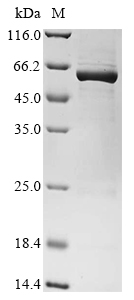Recombinant Bacillus megaterium Bifunctional cytochrome P450/NADPH--P450 reductase (cyp102A1) , partial
CAT:
399-CSB-EP320426FSZ-02
Size:
100 µg
Price:
Ask
- Availability: 24/48H Stock Items & 2 to 6 Weeks non Stock Items.
- Dry Ice Shipment: No




Recombinant Bacillus megaterium Bifunctional cytochrome P450/NADPH--P450 reductase (cyp102A1) , partial
- CAS Number: 9000-83-3
- Gene Name: cyp102A1
- UniProt: P14779
- Expression Region: 2-472aa
- Organism: Bacillus megaterium (strain ATCC 14581 / DSM 32 / JCM 2506 / NBRC 15308 / NCIMB 9376 / NCTC 10342 / VKM B-512)
- Target Sequence: TIKEMPQPKTFGELKNLPLLNTDKPVQALMKIADELGEIFKFEAPGRVTRYLSSQRLIKEACDESRFDKNLSQALKFVRDFAGDGLFTSWTHEKNWKKAHNILLPSFSQQAMKGYHAMMVDIAVQLVQKWERLNADEHIEVPEDMTRLTLDTIGLCGFNYRFNSFYRDQPHPFITSMVRALDEAMNKLQRANPDDPAYDENKRQFQEDIKVMNDLVDKIIADRKASGEQSDDLLTHMLNGKDPETGEPLDDENIRYQIITFLIAGHETTSGLLSFALYFLVKNPHVLQKAAEEAARVLVDPVPSYKQVKQLKYVGMVLNEALRLWPTAPAFSLYAKEDTVLGGEYPLEKGDELMVLIPQLHRDKTIWGDDVEEFRPERFENPSAIPQHAFKPFGNGQRACIGQQFALHEATLVLGMMLKHFDFEDHTNYELDIKETLTLKPEGFVVKAKSKKIPLGGIPSPSTEQSAKKVR
- Tag: N-terminal 10xHis-tagged and C-terminal Myc-tagged
- Source: E.coli
- Field of Research: Cancer
- Assay Type: In Stock Protein
- Relevance: Functions as a fatty acid monooxygenase . Catalyzes hydroxylation of fatty acids at omega-1, omega-2 and omega-3 positions . Shows activity toward medium and long-chain fatty acids, with optimum chain lengths of 12, 14 and 16 carbons (lauric, myristic, and palmitic acids). Able to metabolize some of these primary metabolites to secondary and tertiary products . Marginal activity towards short chain lengths of 8-10 carbons . Hydroxylates highly branched fatty acids, which play an essential role in membrane fluidity regulation . Also displays a NADPH-dependent reductase activity in the C-terminal domain, which allows electron transfer from NADPH to the heme iron of the cytochrome P450 N-terminal domain . Involved in inactivation of quorum sensing signals of other competing bacteria by oxidazing efficiently acyl homoserine lactones (AHLs), molecules involved in quorum sensing signaling pathways, and their lactonolysis products acyl homoserines (AHs) .
- Purity: Greater than 85% as determined by SDS-PAGE.
- Activity: Not Test
- Length: Partial
- Form: Liquid or Lyophilized powder
- Buffer: If the delivery form is liquid, the default storage buffer is Tris/PBS-based buffer, 5%-50% glycerol. If the delivery form is lyophilized powder, the buffer before lyophilization is Tris/PBS-based buffer, 6% Trehalose, pH 8.0.
- Reconstitution: We recommend that this vial be briefly centrifuged prior to opening to bring the contents to the bottom. Please reconstitute protein in deionized sterile water to a concentration of 0.1-1.0 mg/mL.We recommend to add 5-50% of glycerol (final concentration) and aliquot for long-term storage at -20℃/-80℃. Our default final concentration of glycerol is 50%. Customers could use it as reference.
- Molecular Weight: 61.2 kDa
- References & Citations: "Bacillus megaterium CYP102A1 oxidation of acyl homoserine lactones and acyl homoserines." Chowdhary P.K., Keshavan N., Nguyen H.Q., Peterson J.A., Gonzalez J.E., Haines D.C. Biochemistry 46:14429-14437 (2007)
- Storage Conditions: The shelf life is related to many factors, storage state, buffer ingredients, storage temperature and the stability of the protein itself. Generally, the shelf life of liquid form is 6 months at -20℃/-80℃. The shelf life of lyophilized form is 12 months at -20℃/-80℃.
